
Oct 13
Coffee Weekly Report - 2023 10 13
Back to main blog page
- Recent rainfall in Brazilian coffee regions triggered a second flowering for the 24/25 season, increasing optimism regarding next year’s arabica supply.
- Still, precipitation varied widely, with 35% of arabica regions experiencing over 300% of average rainfall and 22% receiving 0-80%.
- Active El Niño affects temperatures, impacting conilon in October and causing elevated temperatures in Espírito Santo and Bahia in December.
- Rondônia faces below-average precipitation in October, while Espírito Santo and Bahia show mixed correlations. Conilon areas expect below-average rainfall in the next two weeks, warranting attention, while concerns for arabica diminish with replenished soil moisture.
- Notably, this year's El Niño differs from past occurrences, with more differences than similarities.
Brazilian Weather Update
Over the past week, coffee areas in Brazil received rainfall levels that triggered the second flowering of the 24/25 season, especially when it comes to arabica. Still, it’s important to note that volumes were not uniform across all areas: whereas 35% of arabica regions received rains above 300% of the average expected for the period, another 22% reported rains between 0% and 80% of normal. As for conilon areas, rainfall levels were even less homogeneous across the board: 65% of areas received precipitation levels between 0% and 80% of the normal levels expected for the period.
Still, it’s important to note that as we enter the last quarter of the year, the currently active El Niño has different impacts over arabica and conilon areas. During the last quarter of the year, the El Niño phenomenon can lead to an increase in temperatures in coffee-producing regions. In October, the conilon-producing region most affected is Rondônia, but Espírito Santo and Bahia are also affected. In December, the effect is different: temperatures well above normal in Espírito Santo and the Bahia Atlantic, while Rondônia records temperatures slightly below average (Appendix I).
Image 1: Arabica production share by precipitation anomaly
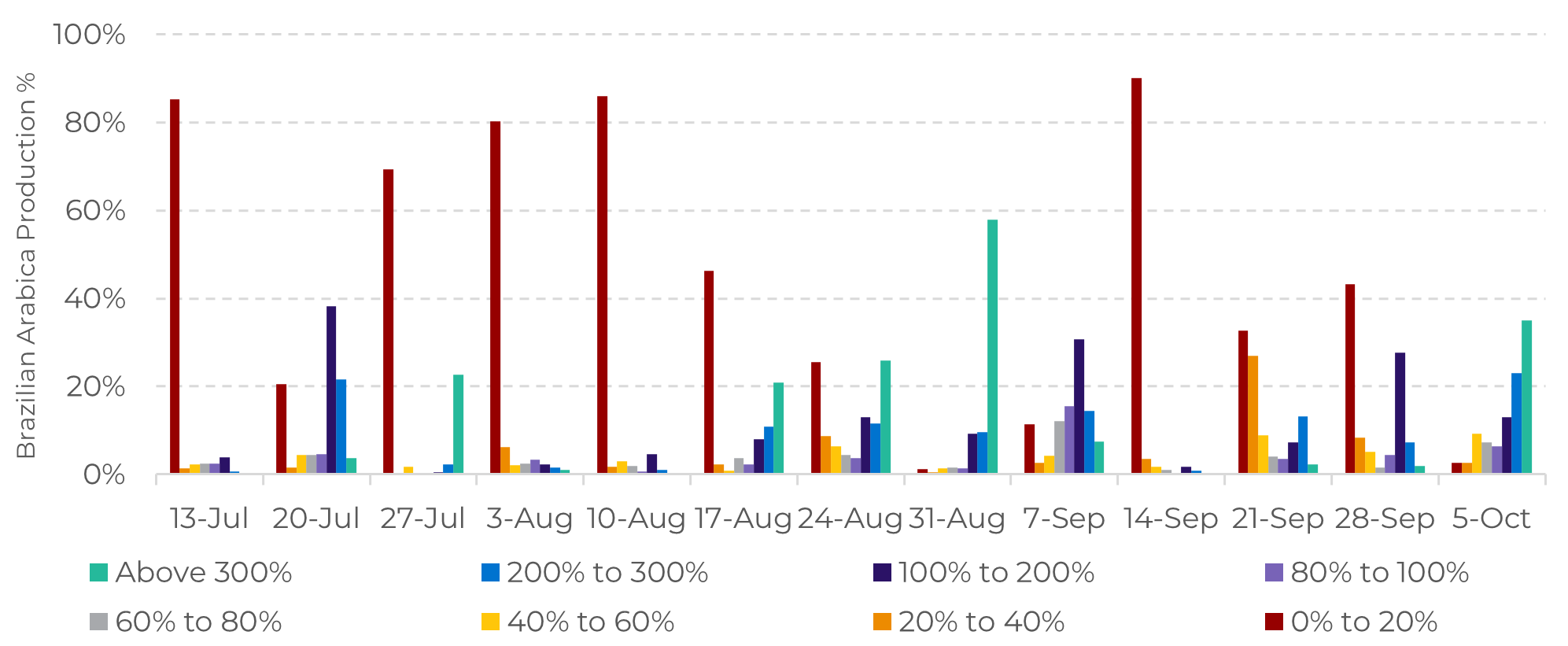
Source: Somar, Bloomberg, IBGE, hEDGEpoint
Image 2: Conilon production share by precipitation anomaly
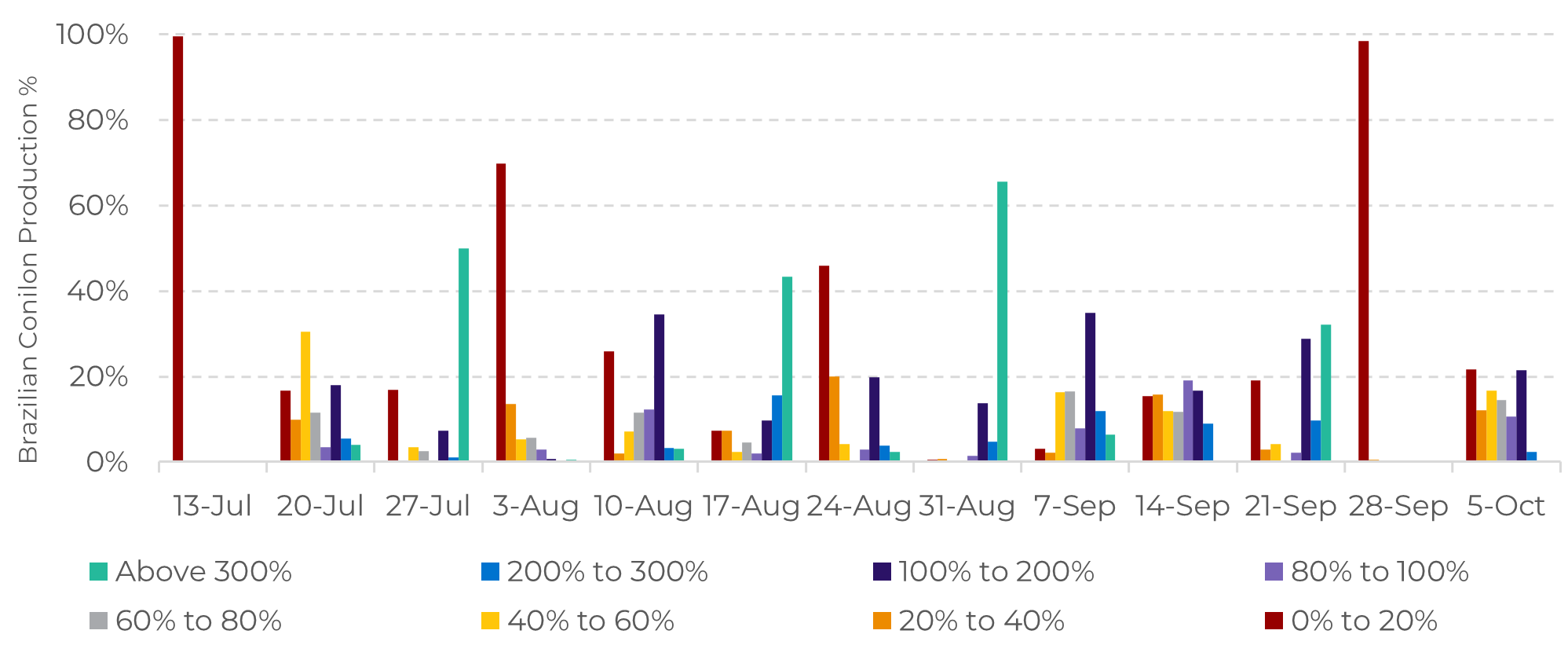
Source: Somar, Bloomberg, IBGE, hEDGEpoint
Regarding rainfall, the scenario remains pessimistic for Rondônia's production: precipitation below normal in October, a crucial period for fruit filling. On the contrary, Espírito Santo and Bahia do not show strong correlations with the El Niño effect on rainfall.
When we look at the last weeks of the year, the picture also changes in terms of precipitation: rainfall returns to the expected average in Rondônia, while Espírito Santo and Bahia may experience below-normal rainfall (Appendix II).
Over the next two weeks, precipitation levels are expected to be slightly below-average for conilon areas, whereas arabica areas carry less concern. With recent rains replenishing soil moisture and average levels expected for the next 14 days, especially in the South of Minas Gerais, immediate concerns regarding Brazil’s 24/25 arabica crop are dissipating by the minute. Conilon, on the other hand, still warrants attention.
Looking at this year’s precipitation levels and past occurrences, it’s important to note that there are currently more differences than similarities when compared to previous years when El Niño was active (for instance, 2010 for arabica, Chart #3).
For conilon, volumes are less volatile across the board considering data until the end of September – the trend usually fans out in the last quarter (Chart #4).
For conilon, volumes are less volatile across the board considering data until the end of September – the trend usually fans out in the last quarter (Chart #4).
Image 3: Monthly Cumulative Precipitation – South of Minas Gerais (mm)
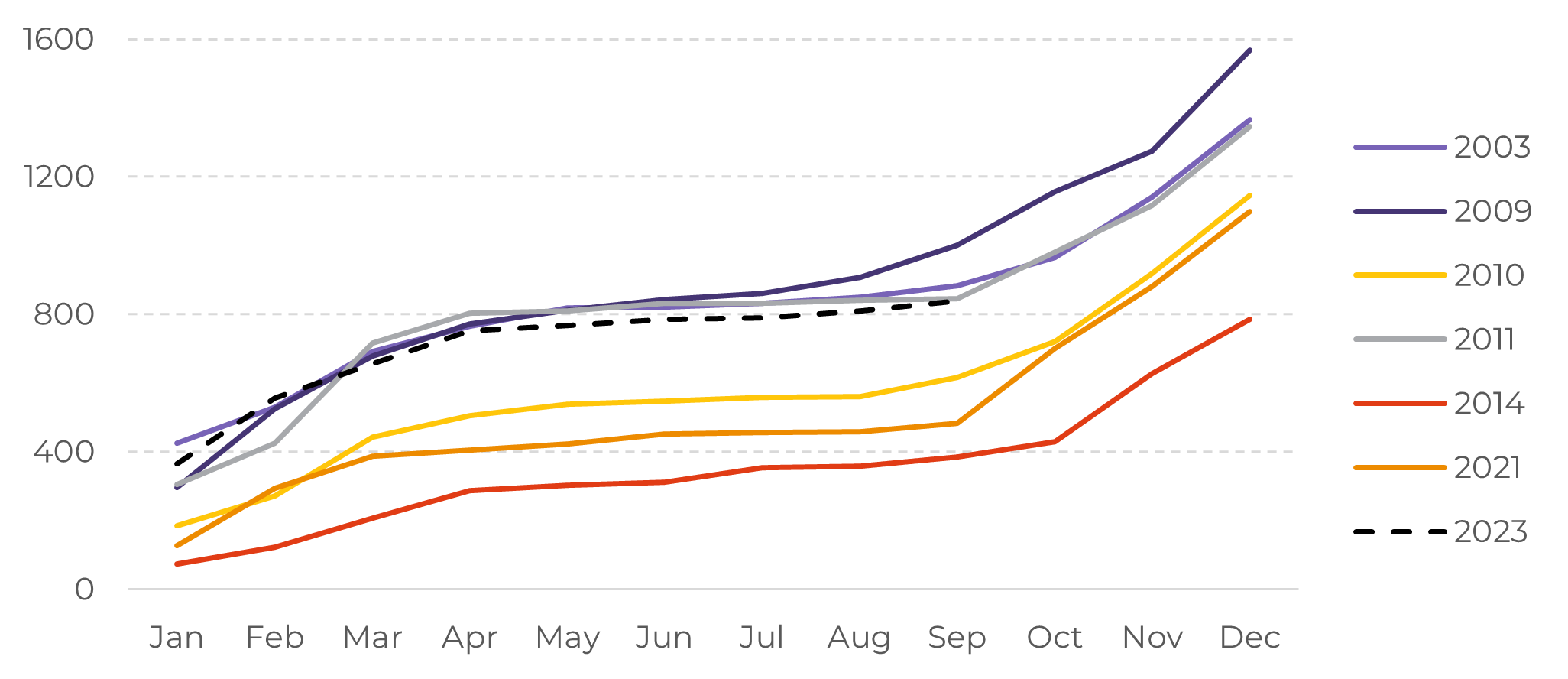
Source: USDA, hEDGEpoint
Image 4: Monthly Cumulative Precipitation – Espírito Santo (mm)
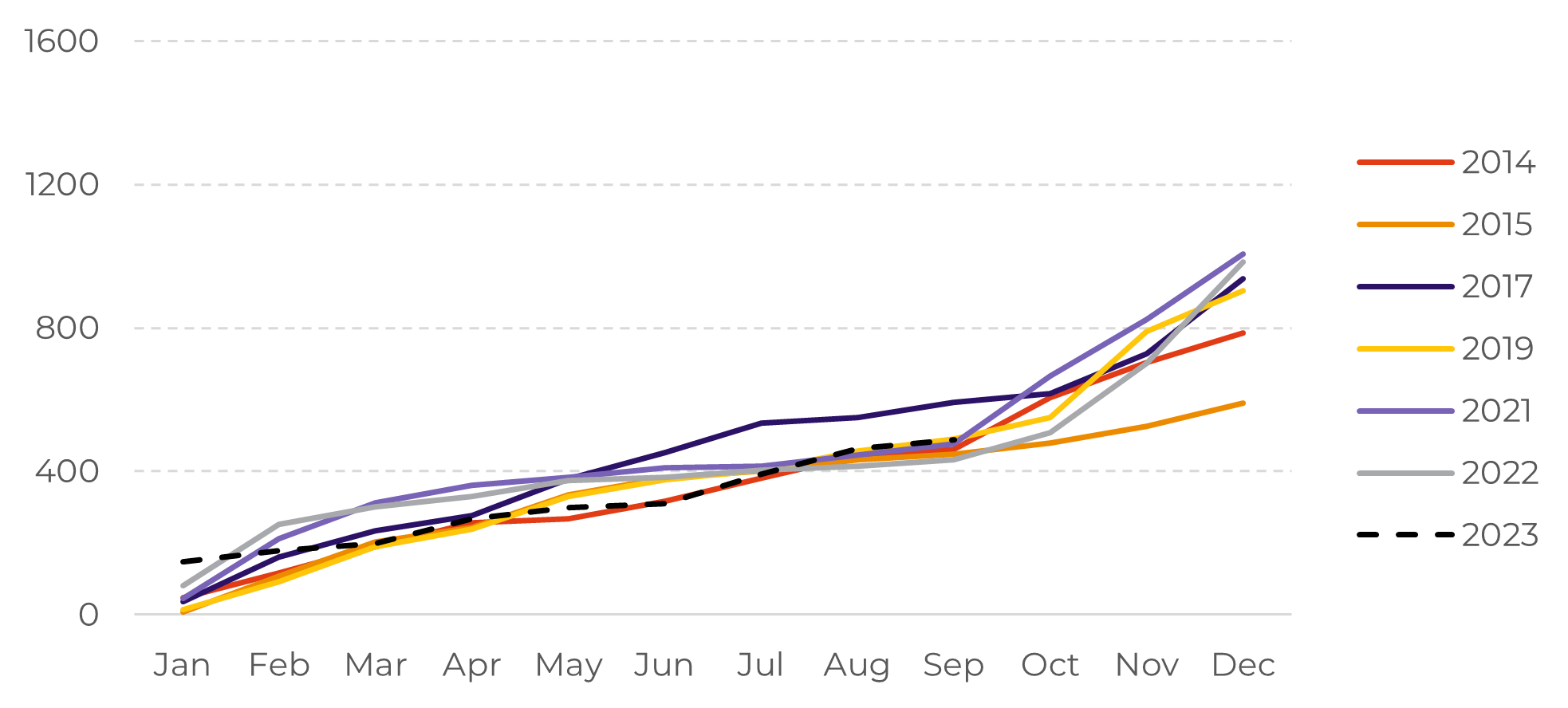
Source: USDA, hEDGEpoint
Appendix I - Temperature anomaly during El Niño events

Source: hEDGEpoint

Source: hEDGEpoint
Appendix II - Precipitation anomaly during El Niño events
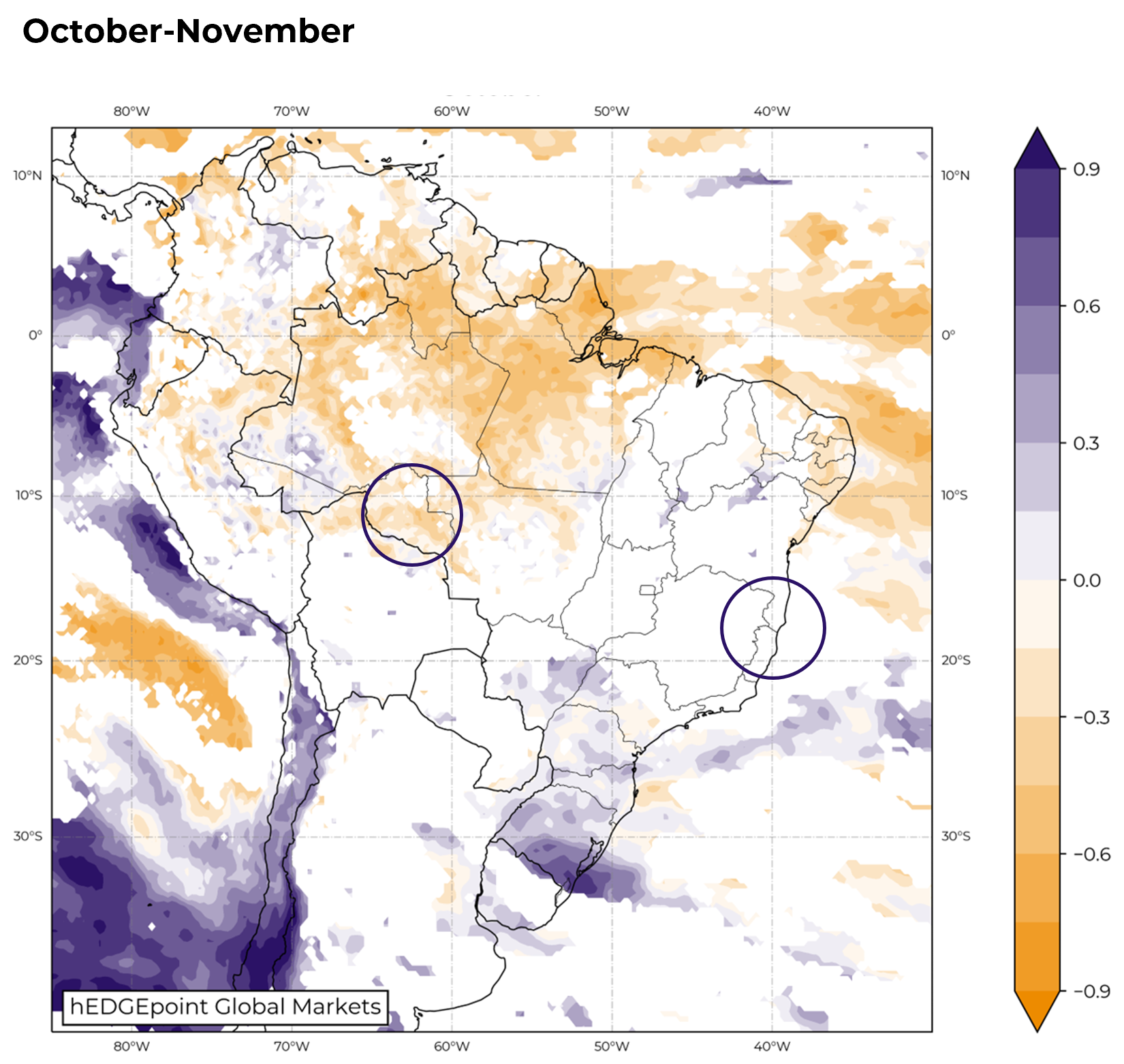
Source: hEDGEpoint
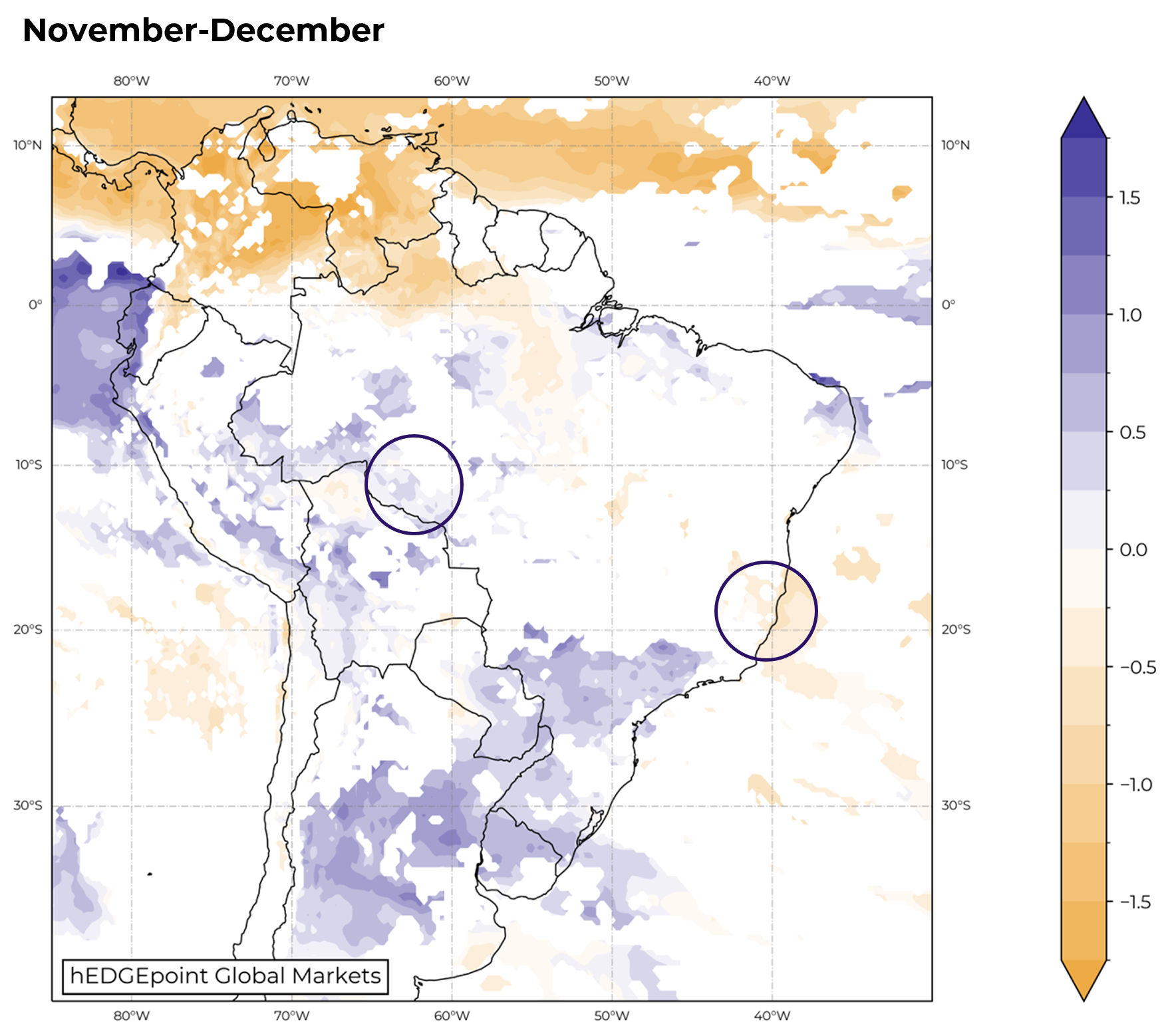
Source: hEDGEpoint
In Summary
Recent rainfall in Brazilian coffee regions triggered a second flowering in the 24/25 season, particularly for arabica. However, precipitation varied widely, with 35% of arabica regions experiencing over 300% of average rainfall, and 22% receiving 0-80%. The active El Niño impacts temperatures in coffee regions, affecting conilon in October but causing elevated temperatures in Espírito Santo and Bahia in December.
Rondônia faces below-average precipitation in October, while Espírito Santo and Bahia show mixed correlations. Conilon areas expect below-average rainfall in the next two weeks, warranting attention, while concerns for arabica diminish with replenished soil moisture. Notably, this year's El Niño differs from past occurrences, with more differences than similarities.
Rondônia faces below-average precipitation in October, while Espírito Santo and Bahia show mixed correlations. Conilon areas expect below-average rainfall in the next two weeks, warranting attention, while concerns for arabica diminish with replenished soil moisture. Notably, this year's El Niño differs from past occurrences, with more differences than similarities.
Weekly Report — Coffee
Written by Natália Gandolphi
natalia.gandolphi@hedgepointglobal.com
natalia.gandolphi@hedgepointglobal.com
Reviewed by Victor Arduin
victor.arduin@hedgepointglobal.com
www.hedgepointglobal.com
Disclaimer
This document has been prepared by hEDGEpoint Global Markets LLC and its affiliates ("HPGM") exclusively for informational and instructional purposes, without the purpose of creating obligations or commitments with third parties, and is not intended to promote an offer, or solicitation of an offer, to sell or buy any securities or investment products. HPGM and its associates expressly disclaim any use of the information contained herein that may result in direct or indirect damage of any kind. If you have any questions that are not resolved in the first instance of contact with the client (client.services@hedgepointglobal.com), please contact our internal ombudsman channel (ouvidoria@hedgepointglobal.com) or 0800-878-8408 (for clients in Brazil only).
Contact us
hedgepointhub.support@hedgepointglobal.com
ouvidoria@hedgepointglobal.com
Funchal Street, 418, 18º floor - Vila Olímpia São Paulo, SP, Brasil
Check our general terms and important notices.
This page has been prepared by Hedgepoint Schweiz AG and its affiliates (“Hedgepoint”) solely for informational and instructional purposes, without the purpose of instituting obligations or commitments to third parties, nor is it intended to promote an offer, or solicitation of an offer of sale or purchase relating to any securities, commodities interests or investment products. Hedgepoint and its associates expressly disclaim any use of the information contained herein that directly or indirectly result in damages or damages of any kind. Information is obtained from sources which we believe to be reliable, but we do not warrant or guarantee the timeliness or accuracy of this information. The trading of commodities interests such as futures, options, and swaps involves substantial risk of loss and may not be suitable for all investors. You should carefully consider wither such trading is suitable for you in light of your financial condition. Past performance is not necessarily indicative of future results. Customers should rely on their own independent judgement and/or advisors before entering in any transaction.Hedgepoint does not provide legal, tax or accounting advice and you are responsible for seeking any such advice separately.Hedgepoint Schweiz AG is organized, incorporated, and existing under the laws of Switzerland, is filiated to ARIF, the Association Romande des Intermédiaires Financiers, which is a FINMA-authorized Self-Regulatory Organization. Hedgepoint Commodities LLC is organized, incorporated, and existing under the laws of the USA, and is authorized and regulated by the Commodity Futures Trading Commission (CFTC) and a member of the National Futures Association (NFA) to act as an Introducing Broker and Commodity Trading Advisor. HedgePoint Global Markets Limited is Regulated by the Dubai Financial Services Authority. The content is directed at Professional Clients and not Retail Clients. Hedgepoint Global Markets PTE. Ltd is organized, incorporated, and existing under the laws of Singapore, exempted from obtaining a financial services license as per the Second Schedule of the Securities and Futures (Licensing and Conduct of Business) Act, by the Monetary Authority of Singapore (MAS). Hedgepoint Global Markets DTVM Ltda. is authorized and regulated in Brazil by the Central Bank of Brazil (BCB) and the Brazilian Securities Commission (CVM). Hedgepoint Serviços Ltda. is organized, incorporated, and existing under the laws of Brazil. Hedgepoint Global Markets S.A. is organized, incorporated, and existing under the laws of Uruguay. In case of questions not resolved by the first instance of customer contact (client.services@Hedgepointglobal.com), please contact internal ombudsman channel (ombudsman@hedgepointglobal.com – global or ouvidoria@hedgepointglobal.com – Brazil only) or call 0800-8788408 (Brazil only).Integrity, ethics, and transparency are values that guide our culture. To further strengthen our practices, Hedgepoint has a whistleblower channel for employees and third-parties by e-mail ethicline@hedgepointglobal.com or forms Ethic Line – Hedgepoint Global Markets.Security note: All contacts with customers and partners are conducted exclusively through our domain @hedgepointglobal.com. Do not accept any information, bills, statements or requests from different domains and pay special attention to any variations in letters or spelling, as they may indicate a fraudulent situation.“HedgePoint” and the “HedgePoint” logo are marks for the exclusive use of HedgePoint and/or its affiliates. Use or reproduction is prohibited, unless expressly authorized by HedgePoint. Furthermore, the use of any other marks in this document has been authorized for identification purposes only. It does not, therefore, imply any rights of HedgePoint in these marks or imply endorsement, association or seal by the owners of these marks with HedgePoint or its affiliates.
We have updated our Terms & Conditions to reflect improvements to our platform, data handling practices, and the overall experience we provide to our clients.
To continue using the Hedgepoint HUB, please review and accept the updated terms.

